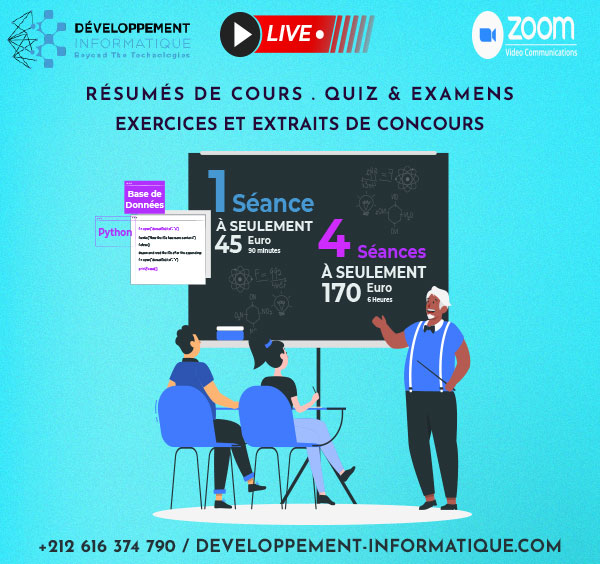Introduction to database
Introduction to data management
Each student provides the administration of his school with the documents necessary to form a file for obtaining his scholarship after his success.
The necessary documents are:
- Id Photocopy
- Father and mother salary certificate
- Tax sheet.
At the general directorate of education (MEN) an agent brings together the different files and verifies that all the documents are complete and draws up a file for each pupil containing a number, surname and first name, address and high school and returns these files to service (MENHATY)
In the MENHATY service, an agent checks the accuracy of the documents and enters all the information necessary for any student in a computer so that the latter displays a decision: refusal or acceptance.
"MENHATY" is a service in the ministry of education in Morocco, which gives scholarship to high school students depending on many facts
Question : give a name for each step for the processing of files
Reply :
- Collection of information: Collection
- Creation of a file:
- Document verification: Control
- Entry of information into the computer: Entry
- Result display: Processing and result
Information for each student forms data for each.
Definition
Data is a basic description of information
Several data grouped together and relating to the same context give rise to the information.
The building blocks of information
- Information refers to a real world object: it is the entity
- An entity is described by a set of data: these are the attributes
- An attribute takes on different values with a specific type of data (Text, Numeric, date, etc.).
- Entities can have links between them : relationships
Example :
- The entity: Student
- Attributes: Id, last name, first name
- The values: 021455898, ESSADDOUKI, Mostafa
Persistence
- In order not to lose this data, what must be done? (Backup, recording, memorization, storage).
- In what way ? (Paper or IT tool)
So information that tends to get lost is volatile information which is different than persistent information, so
Persistence = memorization + availability
To memorize information, you can use: paper or a computer tool and form a file:
- The paper organization : It consists of using papers, registers, files, etc.
This organization has several drawbacks: classification, search, size, etc. - The file organization: It consists in using a computer tool to save the information.
This solution has als several drawbacks: access time, redundancy of information, writing the program on each access, etc.
Following these cited drawbacks, research has been carried out to find an optimal solution which has given rise to database concepts.
Databases
Definition
A coherent computer system of information likely to be used simultaneously by several people.
In fact, a database is a collection of files shared by several users. It is therefore a set of structured, secure, consistent and shareable data.
Benefits of a database
- Centralization : Data is entered only once which avoids redundancy and can be used by several programs and several users.
- Independence of data and programs : The data is described independently of the programs
- Data integrity : A database is subject to fundamental rules (uniqueness, reference, value) to ensure its consistency
- Data sharing : Several users access the database at the same time without disturbing its operation
Database models
There are 3 models of databases; the difference between the three is the representation of the links between the data in the database
- The hierarchical model : The possible link in this model is father-son: an object can have several sons but a son has only one father.
- The network model : A network database looks like a graph, or network
- The relational model : Entities and links are represented in the form of tables in the form of a two-dimensional table.


